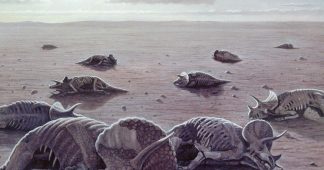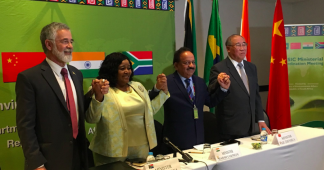Significance
The recent Paris accord on global climate change is a key step in acknowledging biophysical limits to human actions, but the challenge of respecting the biosphere’s ecological limits remains underrated. We analyze how respecting these limits squarely conflicts with an economy centered on growth and technology to mitigate environmental stress. The need to mitigate human impacts on species and natural systems has made conservation science a major multidisciplinary discipline. Society and conservation science have tried unsuccessfully to resolve this need within the growth paradigm. We show that its resolution increasingly demands profound shifts in societal values. Our aim is to identify the nature of these necessary shifts and to explore how they define future paths for conservation science.
Abstract
Increasing human population interacts with local and global environments to deplete biodiversity and resources humans depend on, thus challenging societal values centered on growth and relying on technology to mitigate environmental stress. Although the need to address the environmental crisis, central to conservation science, generated greener versions of the growth paradigm, we need fundamental shifts in values that ensure transition from a growth-centered society to one acknowledging biophysical limits and centered on human well-being and biodiversity conservation. We discuss the role conservation science can play in this transformation, which poses ethical challenges and obstacles. We analyze how conservation and economics can achieve better consonance, the extent to which technology should be part of the solution, and difficulties the “new conservation science” has generated. An expanded ambition for conservation science should reconcile day-to-day action within the current context with uncompromising, explicit advocacy for radical transitions in core attitudes and processes that govern our interactions with the biosphere. A widening of its focus to understand better the interconnectedness between human well-being and acknowledgment of the limits of an ecologically functional and diverse planet will need to integrate ecological and social sciences better. Although ecology can highlight limits to growth and consequences of ignoring them, social sciences are necessary to diagnose societal mechanisms at work, how to correct them, and potential drivers of social change.
Our increasing human population faces difficulties in interactions with local and global environments. The erosion of biodiversity and of basic resources raises questions about core societal values shaped when our footprint resulted from an orders-of-magnitude smaller population and lower per capita resource use. These values center on growth and rely on technology to mitigate environmental stress, depletion of natural resources, and loss of biodiversity.
Biodiversity loss is a seminal concern of conservation scientists. Their focus on protecting wild plants and animals and conserving viable portions of species and habitats (1⇓–3) included emphasizing conserving natural resources needed by humanity (cover statement of Biological Conservation, Vol. 1, No. 1, 1968). The emergence of the Society for Conservation Biology in 1985 expanded the aim to averting what Soulé (4) termed the worst biological disaster in the last 65 million y and favored the rise of a scientific discipline aware of the critical role societal values will play in the outcome (4).
The third millennium saw further realization of the dramatic human impact on the biosphere (Millennium Ecosystem Assessment, www.unep.org/maweb/en/index.aspx). Nature conservation and care for social issues, such as human health, well-being, and justice, became intimately intertwined with environmental issues and sustainable resource use.
The idea of the need to address the environmental crisis in a holistic and social context became embedded in a greener version of the current economic paradigm, in which green growth and technology would ameliorate environmental stressors. However, these efforts seemed unable to affect the major drivers threatening biodiversity, identified in a recent World Wide Fund for Nature (WWF) report (wwf.panda.org/what_we_do/how_we_work/tackling_the_causes/) as (i) national and international laws and regulations, (ii) public sector finance that determines resource allocation and the degree of environmental concern, (iii) private sector finance and its level of concern for environmental and development issues, (iv) business practices and their concern for environmental impact, and (v) consumption choices and attitudes toward nature. All pertain to key components of the world economy and core societal values.
Tackling the present environmental crisis will require fundamental societal shifts in values; principles and attitudes shaped by conservation science will be challenged in the process.
The Current Growth Paradigm in Society
The Forces Leading to the Neglect of Limits.
During the eighteenth century, sophisticated fire-powered machines led in the West to the emergence of two divergent visions about the finitude of human material production and, ultimately, about their dependence on the biophysical and ecological limits of the biosphere (5, 6). On one hand, these machines helped Sadi Carnot understand that work entails transforming a source of energy into heat and work, an inexorable dissipation of resources restricting human productivity. On the other, the same machines fueled the industrial revolution and a shift from a perception that production is limited by what can be drawn from the land through muscle, hydraulic, and wind power to a perception of unlimited production based on technological innovation and massive use of nonrenewable fossil energy sources. This notion of a limitless human-built world (7) was encouraged by voyages of exploration that heralded the wealth of resources to be found on the planet. The rise of colonial empires contributed to the emergence of a paradigm of unlimited growth. By extending the frontiers of their dominion, colonialists accessed resources in far greater quantity and variety and externalized their ecological footprint (8).
Economics also underwent its own revolution, leading to a science based on free trade and maximizing self-interest (see ref. 9, but also ref. 10 and critiques in ref. 11). The idea that technological progress freed economic activities from limitations imposed by nature became central. Increasing mass production after World War II led to an economy of mass consumption, with economic growth at its core and the gross domestic product (GDP) as its performance measure. Its strongest supporters dismiss any limits to growth (12).
Objections to an Economics of Growth.
In the late 1920s, Vernadsky (13) integrated human activities in the broader context of a living but limited planet in the concept of biosphere. Georgescu-Roegen (5) used this integrative concept to analyze the inevitable degradation of energy stocks used to produce work and of key resources such as minerals. As recent levels of economic growth were enabled by geological anomalies that provided easy access to low-entropy energy stocks (14), their depletion will increase energy and expense needed to extract less accessible stocks. This thermodynamic degradation was not integrated in the current economic models, and Georgescu-Roegen (5) saw regulation through market forces as a fiction economists developed only by ignoring physical and ecological limits imposed by the biosphere. He emphasized that a system in which human needs increasingly require nonrenewable sources of energy jeopardizes the future satisfaction of these needs. The necessity to reduce greenhouse gas emissions further severely limits the use of fossil fuels.
Limits to growth were also central to work by the Club of Rome (15), which simulated the interaction between Earth’s and human systems under the economic growth paradigm and explored scenarios that would avoid overshoot and collapse. Turner (16) found that observed changes in industrial production, food production, and pollution, 40 y after the report, were consistent with the Club of Rome’s projection of an economic and societal collapse during the 21st century (16). Turner also emphasized the critical role moderating the size of the human population would play in the outcome. The Club of Rome report heavily influenced conceptions of environmental issues. Its most vocal critics were economists such as Solow (12), proficient in elucidating the interplay between capital and technological innovations in driving the economic engine but less familiar with fundamentals of ecology or thermodynamics.
Attempting to Green the Economy.
The second half of the twentieth century saw attempts to reconcile acknowledgment of energetic and ecological limits and a continued push for economic growth, within economics itself and between economics and the sciences.
Within economics, Daly (17) developed the concepts of sustainable development and of “circular economies” that rely on recycling resources. However, recycling and improved efficiency of energy use may slow the rate of resource erosion but will not stop it (14, 18). Furthermore, innovations in energy use efficiency do not necessarily decrease net consumption and can increase demand by lowering prices, as Jevons showed over 150 y ago (19).
To grapple with externalized costs, Kneese (20) promoted the concepts of mitigation and carbon credits, pollution allowances, and green taxes. Although green taxes can be viewed as state-controlled pigovian taxes, many of these measures were in line with concepts advocated by the “new institutional economics” (21), which entrusted common goods and externality resolutions to market forces by transforming them into commodities .
The need for a technological “greening” of the economy implied developing ways to reduce our dependence on nonrenewable energy and resources to produce goods and services. But producing renewable energies also faces the challenge of increasing acquisition costs because of the need to produce, maintain, and renew infrastructures needed to capture them (e.g., need for rare earth elements to produce magnets of wind turbines) (18).
Even under this green stimulus, the idea of economic growth remained central and retained an unsustainable nature, prompting strong reservations about the idea of sustainable development (22). For Grinevald (23), entropy and economy together with ecology must be integrated into a global perspective of the environment that accounts for limits to growth. He pled for an economy placed within, rather than outside, the more general context of ecology.
Economics and Human Development.
Although many economists and political scientists assume that economic growth through increased consumption is a necessity for human development (but see 19th century work of Mill on a stationary state economy) (24), Schumacher (25) questioned the validity of measuring “standards of living” via levels of consumption and advocated an economy that maximized well-being while minimizing consumption. Beyond a certain point, growth does not increase human well-being (26), and several studies (e.g., in Alberta, Finland) have documented the decoupling of the GDP (27) from well-being, the latter estimated through indices such as the genuine progress indicator (GPI). All showed trends of stagnating or even decreasing GPI (including physical, material, and psychological well-being, social justice, peace, etc.) over the past 30 y despite major increases in GDP.
Jackson (26), arguing that “prosperity without growth was [not] a utopian dream but a financial and ecological necessity,” proposed three steps to achieve a transition freed from the need to grow: (i) building a sustainable macroeconomy, (ii) protecting capabilities for flourishing, and (iii) recognizing ecological limits, including those imposed by the need to conserve biodiversity, a central concern for conservation science. This view raises the question of what conservation science should be within the framework, to be defined, of prosperity without growth.
An Alternative and Ethical Framework: From Conquest to Respect
From a Technical to an Ethical View of Affluence.
Critiques of the growth paradigm (22) echoed a call for simpler ways of life by thinkers like Gorz (28). Gorz saw self-imposed frugality as an ecological and social necessity to meet resource limitations and access to resources for needy members of society. For Gorz, poverty was relative; in Vietnam, it meant walking barefoot; in China, lacking a bicycle; in France, lacking a car; in the United States, having a small car. He saw poverty as the inability to consume as much as your neighbor, and destitution as the inability to satisfy basic needs for water, food, medical assistance, shelter, and clothes. From this perspective, alleviating deprivation is more crucial than alleviating poverty, which itself might be more easily achieved by reducing affluence of the rich than by increasing affluence of the poor. This change of focus about inequities might be a necessary condition to acknowledge ecological and biophysical limits.
From Heteronomy to Autonomy.
Castoriadis (29) analyzed the growth paradigm in relation to how societies construct their values. He defined societies as heteronomous when they consider their values, social norms, worldviews, and laws as transcendent, true, just, and universal extrasocietal emanations. Such transcendent “truths” can bear names such as God, human nature, or economic laws.
Heteronomous societies have difficulties questioning and modifying their values in response to environmental changes or to their own evolution. For our society, questioning the economic–technological growth paradigm is such a challenge. Castoriadis contrasts heteronomous with autonomous societies, which constantly question how they conceive themselves, their norms, and their aims as mental models that must be revisited by each individual to adjust to change and to care for all members. Castoriadis (29) contends that almost all societies have been heteronomous.
In the current heteronomous economy, Illich (30) and Ellul (31) focused on the role technology plays in producing concentrations and monopolies. Illich linked the goal of ever-increasing productivity to a pervasive trend to develop “radical monopolies.” These monopolies impose new, often sophisticated technologies that prevent use of preexisting less sophisticated ones. Four-lane highways reduce the use value of an itinerary by pedestrians or cyclists and “impose” investing resources in acquiring a car, with potential counterproductive outcomes. Illich also claimed that more sophisticated technologies lead to more exclusive use by individuals most adapted to them and reduce the diversity of goals these technologies can be used for. Illich’s concept of “conviviality” parallels Schumacher’s (25) advocacy of self-reliant economies based on user-friendly and ecologically suitable technologies.
Perceptions and Foundations for an Alternative Framework.
Is there an alternative to a fatalist acceptance of the incompatibility of our desires, and of the values and representations that shape them, with the limits of the biosphere? A shift toward resignation and self-deprivation would hardly raise popular support. This lack of support, however, may rest on failure to recognize that many perceived self-limitations could ultimately improve sense of self and quality of life. For most people, shifting from car to bicycle for short trips is perceived as self-deprivation. This perception contrasts with that of individuals who have taken this step, who feel they have gained freedom, pleasure, and health (32). The challenge may then be achieving greater ability to juxtapose desires, values, and representations with limits imposed by reality to adjust each of them through technological and environmental sobriety and literacy. This proposal, based on increased frugality rather than deprivation, does not discard technological means for sustainability but sees them as only part of the solution. The other part is to recognize that dominant values and representations have led to an unsustainable state of affairs and to identify how they can evolve toward a more satisfying biophysical sustainability and social and cultural flourishing.
Unsustainability is thus a symptom of an ill-suited representation of the human–nature relationship. The current anthropocentric paradigm, developed in the “age of wonder” (33), was perceived as appropriate two centuries ago, when land and resources available to a smaller human population were thought to be infinite and demand for them and the ability to exploit them were far lower. But a revision is needed. Human societies depend much more on nature than has usually been admitted, and the vision of a domesticated world in need only of better management (34) is simplistic. Nature is not a passive substrate that can be endlessly appropriated, manipulated, and controlled. The dependence and dynamic relationships between human beings and nature warrant reconsidering the values we ascribe to nonhuman entities. This reconsideration is needed to define better how conservation science can help us to cope with the ecological limits of the planet.
The Nature of Respect, and Respect for Nature.
An extremely influential ethical framework considers human beings as the only proper subjects of direct moral consideration. Indeed, moral considerability has generally been rooted in rationality, and the corollary ability of rational persons to fix their own ends. In this perspective, although humans are ascribed an intrinsic value, everything else is ascribed only an instrumental value relative to its contribution to the pursuit of human ends. This radical instrumentalization of nature, embedded in Christianity and reinforced by the modern faith in technology, has led to an exploitative attitude toward nature and the present ecological crisis. Environmental ethics has challenged this “human chauvinism” (35) as being morally arbitrary. Nature and natural entities have their own dynamics and their own goods that are independent of human purposes, and they deserve a certain kind of moral respect.
However, once we contemplate moving from a strictly instrumental relationship to nature to a more respectful one, problems arise. First, which nature are we talking about? Should respect be focused on individual nonhumans, such as sentient beings (36) or every living being (37, 38), or should we be respectful toward the kind of complex entities that conservation cares for, such as populations, species, ecosystems, or landscapes (39)? Second, what actually constitutes respect toward nonhuman entities? The answer for individual organisms certainly has to do with their ability to live, flourish, and reproduce. But how can we know what is good for a species or an ecosystem? And third, how can we balance divergent responsibilities toward different human and nonhuman entities (40, 41)? Nature or natural entities cannot speak for themselves. The best we can do is to hypothesize about what is good for other beings.
In any event, the first step is to admit that other interests than human ones should be taken into account. Then, facing the huge uncertainties about how to respect and enhance opportunities for the rest of the living world, we should explore, experiment, and deliberate collectively. Here, the biophysical and ecological limits of the planet can give both a moral motivation for respecting nature and an indication about how to do this. Indeed, the present disruptive condition of the whole biosphere is a symptom of our troubled relationship with other living organisms and, at the same time, an indicator of the paths to follow to rebalance this relationship.
To acknowledge that the current environmental crisis calls for revising the dominant anthropocentric paradigm does not imply that it should be replaced by a ready-made universal moral framework. Rather, it calls for a different way to think about ethics in which these crucial issues (What is nature? What is respect for nature? How to balance divergent goods?) need not be resolved once and for all but necessitate continuous, context-specific investigation. The notion of respect toward nature and natural entities could thus serve as an open horizon to be characterized in different contexts and by different publics and cultures to shape a new relationship with nature, sustainable for both humans and nonhumans. The respect for nature could then take the form of a prima facie respect for the limits of the planet because the overuse of natural resources and climate imbalance are strong indicators that the current path of development is incompatible with the flourishing of nature and natural entities, as well as the survival of many nonhuman species.
Ethical Challenges and Obstacles to Change.
Three societal segments, as individuals and economic sectors, will likely resist a changed perspective based on respecting limits imposed by nature: free-trade advocates; those with faith that technology can solve the problems ahead; and those who benefit financially from overusing resources. The first two provide the ideas fueling the race ahead, the latter the means to run it. These actors capitalize on their ability to exploit the human appetite for novelty, acquisition of goods, status, and identity. They conceive of human beings as selfish individuals and social interactions as a vast competition for resources and power (42, 43). The different forms of capitalism shaping today’s economies are so tightly coupled to these premises that a change in perspective will test our ability to conceive a novel form of economy. Such a worldview would recognize and encourage other key human characteristics, like altruism and the ability to cooperate toward a common good (44). A pluralist conception of human nature and society, in which selfishness and altruism coexist and balance each other, is much more believable (45).
Another deeply rooted behavioral characteristic to overcome is our penchant for denial in the face of issues we feel we cannot master. In a world with victims and beneficiaries, denial is an easily manipulated feature. The current climatic trends may exemplify a situation in which the combination of a financial crisis and challenges to the Intergovernmental Panel on Climate Change (IPCC) (46) allowed a global bloom of skepticism surfing on denial. Denial hinders states from considering alternatives to pursuing economic growth. The contradiction between this pursuit and an ecological agenda results in a cognitive dissonance, sensu Festinger (47), resolved through attempts to reconcile growth and ecology in another form of denial.
The combination of denial, uncritical faith in technology, and the anesthetic effect of modern comfort may result in a psychological weakening preventing a decisive shift from the current “age of plunder” toward an “age of respect” that accepts a world governed by biophysical limits. This shift would mirror the shift in the 18th century at the dawn of the “age of wonder” (33), when geographic and scientific discoveries provided a romantic sense of limitless opportunities. How can conservation science foster or impede a shift toward an “age of respect”?
Challenges Posed to Conservation Science Within an Alternative Framework
Birth and Short History of Conservation Science.
Aiming at biodiversity protection, conservation science is inherently value-laden (48). However, it must be able to constantly question and adjust the values that shape it to address environmental and social changes. Modern conservation science arose in the mid-1970s from a confluence of (i) interest in principles of refuge design based on the equilibrium theory of island biogeography, and (ii) the notion that inbreeding depression and genetic drift endanger small populations isolated in refuges (49). This synthesis remained focused on saving particular species perceived as endangered in a school of thought Callicott et al. (39) termed “compositionalism.” Excitement about a modern science of conservation crystallized with the founding of the Society for Conservation Biology (SCB) in 1985 and initiation of its journal, Conservation Biology, in 1987. The establishment of the SCB also formalized a growing sense that species extinction was a leading edge of a massive global crisis associated with societal values (4). However, the notion that the crisis arose from a failure to recognize physical and ecological limits was absent or, at best, implicit, and Soulé (4), reflecting on the nascent SCB, suggested that intelligent use of technology could provide sufficient redress.
The founding of the SCB coincided with the sudden increase in use of the term “biodiversity” in conservation (50). Although it pertained to diversity at the gene, species, and ecosystem levels, through the 1980s, the focus remained heavily on species (51). Claims that the conservation target should shift toward ecosystem-level biodiversity became increasingly insistent in the 1990s, and diversity of ecosystem processes was proposed as a key component of biodiversity (52). In turn, the focus on ecosystems and their processes led to the notion that natural resources and biodiversity should be managed primarily at the ecosystem level. Soon after its introduction in 1991 (53), this concept of “ecosystem management” came to dominate resource agencies in the United States (54). The target of conservation shifted to ecosystem processes (55), in what Callicott et al. (39) qualified as “functionalism.” Although some advocates of ecosystem management argued that the processes were important precisely because they were crucial to particular species (e.g., ref. 52), skeptics feared that the focus on processes could devalue traditional species conservation (55). But the shift in emphasis to ecosystems did not entail recognition that the perceived conservation crisis arose from not understanding biophysical limits.
In the 2000s, the perception of crisis heightened. Conservation scientists increasingly noted the global reach of proximate forces threatening species, ecosystems, and ecosystem processes, particularly climate change. In addition, functionalism in conservation science increasingly associated conservation of species, ecosystems, and ecosystem processes with human well-being. The global nature of conservation problems, the sense that biodiversity issues are part of a biosphere-level crisis including human well-being, and the focus on ecosystems and their processes as measures of the crisis and targets for managing it were codified in the Millennium Ecosystem Assessment (56). The latter, however, construed all aspects of the biosphere, including “wild” nature, as of instrumental value for humans (57). Ecosystems and their species provide various direct services to humans, such as flood control or food or “cultural services,” including “aesthetic” and “religious” services, which contribute to “feeling well.”
Conciliation of Conservation with Economics: A Cul de Sac?
Its history and a sense of urgency caused conservation science to remain largely impact-oriented, with only occasional attention to the links between its issues and the broader societal context. Rather, its increasing calling on market-based notions, such as impact mitigation, biodiversity offset, ecosystem services, and monetary valuations, implicitly connotes acceptance of a growth paradigm eliciting compensatory measures. Beyond the pragmatic acceptance of economic constraints, some of these trends extended a neo-liberal rationale to a new domain: for instance, by promoting “market-based conservation instruments,” such as offset schemes and payment for ecosystem services (57).
Identification of impacts related to actions was usually central and often focused on biodiversity and legally protected entities. Offsets and mitigation were designed to allow protected species or habitats to be destroyed so long as the impact was assessed and compensated. After this impacted and nonimpacted assessment, mitigation of negative impacts has been explored, with assessment by different stakeholders varying with their interests. Even the United States Endangered Species Act, an uncompromising conservation law, has a proviso for permissible elimination of a certain number of individuals upon agreement to mitigate the damage. Often a cost/benefit analysis has been used although some mitigation programs, such as the Endangered Species Act, mandate mitigation even for an entity not perceived as having monetary value or providing a service. This search for mitigation often favored short-term fixes rather than long-term visions (58).
These market-inspired strategies for conservation reinforce the anthropocentric view of nature by narrowing our relationship with nature and natural entities to its strictly economic aspects. Can such a “conciliation conservation” incorporating market realities (59) do more than slow the erosion of natural resources? Translating natural assets and services into a currency compatible with the exchange of commodities to save them (e.g., ref. 60) is too narrow and potentially detrimental (61). Turning natural assets into fragments liable to counting and instrumental use reduces social–natural relations to market transactions. This reduction can lead to neglect of natural features that cannot be monetarily valued, a risk compounded by severe asymmetry in the valuation exercise. How is one to assign monetary value to biodiversity of tropical forests (e.g., ref. 62) or to balance the easily estimated costs carnivores cause to husbandry (63) against their ecological value (64), which is difficult to quantify economically (e.g., ref. 65)? This economic valuation implicitly makes all species fungible. So long as they provide the narrowly defined set of services, it does not matter which species is maintained. Neither does it matter whether a technology provides the service as well as a species does.
Reconciling economy and conservation will require clarifying the relative positions of the economy, society, and environment. Conservation has often been placed at the intersection of three rings representing the economy, society, and the environment (66). A nested model, emphasizing that there is no economy without society and that all human societies critically depend on their natural environment (67), places the economy inside society and the environment as embracing society and economy. It contrasts with the current primacy of the economy, in which environments and often societies are considered as mere resources. It emphasizes that economy depends on society and its environment (68). It acknowledges ecological limits and could help conservation science redefine its interactions with economy and technology.
Symptom Treatments and Techno-Ecosystems: Solutions or Illusions?
Conservation science’s interaction with technologies is complex. Early on, its concerns about species extinctions involved using innovations in captive propagation to buy time for threatened species, often at a cost in fitness (e.g., ref. 69). The broadening of its focus to faunal changes, invasions, and restoration increasingly emphasized hands-on approaches with some remarkable successes (70). The local or specific emphasis still lacked the generality needed to face the systemic context of erosion of biodiversity and ecological processes.
When hands-on approaches expanded from species to ecosystems, they rested on contrasted attitudes. One was of resignation and acceptance that the world will be dominated by techno-ecosystems, built and engineered on principles that were not ecological and essentially powered by fossil energy (71), and by “novel” ecosystems (72), defined as having been heavily influenced by humans but no longer under their management. The notion of novel ecosystems potentially leads to acceptance of a “fait accompli” and a vision of “a ‘domesticated’ Earth, governed by a hubristic, managerial mindset” (73). However, where these ecosystems already exist, trying to make them more “useful” for biodiversity is one possible valid objective, as long as it is coupled with preventing less impacted places from following the same trajectory (72).
Restoration ecologists, in their efforts to restore ecological properties in degraded ecosystems, personify another attitude. Recognizing that all ecosystems are constantly changing to a varying extent, they attempt to realign an ecosystem’s ongoing development with its historic trajectory so that it evolves in response to future conditions (74). Some discrepancy will exist, but the goal is to assist an ecosystem that has evolved over millennia to continue on its path.
Ecological engineering (75) can be defined as an attempt to find a more generic approach that aims to cure rather than treat symptoms. The purpose is to shift from the alliance of engineering and hard sciences that shaped the human-built part of the world to an alliance with ecology to restore natural functions even in systems most influenced by humans. This prescriptive discipline (76) is rooted in ecology and defined as “the design of sustainable ecosystems that integrate human society with its natural environment for the benefit of both” (75). Centered on manipulating natural or artificial ecosystems by integrating applied and theoretical ecology, its ambition remains, despite minor interactions with ecological economics (75), restricted to injecting ecological thinking into the way growth-based societies shape the world. The same is true for ecological intensification, a recent development relying on technologies to circumvent ecological limits to land productivity [e.g., applied to agriculture (77)].
All these avenues address the ecological crisis by relying on technology-based hands-on actions. All have faced critiques pertaining to risk of neglect or, worse, abandonment of natural ecosystems, and/or to the belief that human ingenuity will somehow allow natural ecosystems to exist as human needs are met. These risks are compounded by lack of a clearly stated vision by conservation science that would emphasize and serve the need for a change in perspective for society at large and the need to acknowledge limits imposed by the biosphere. Such a vision would help conservation science replace the pitfalls of techno-fix options by technological literacy, leaving the role of technology for the “emergency room” rather than using it as the default approach. In such a context, mitigation or remediation could be revisited as ways to provide additional opportunities for nature rather than simply to compensate for local impacts within an inappropriate framework.
“Wise Domestication” or “Wise Wilding”?
Many conservation biologists feel a need to overcome the uneasiness with which, despite their efforts and successes, they witness a continuing erosion of biodiversity and natural processes (78, 79). This need may explain attempts to seek new paths that abandon the notion of conservation at large to focus on novel ecosystems (72) or to propose a “new conservation science” that emphasizes conserving what serves humans best (79), helps “humanity to domesticate nature more wisely” (34), and in which “needs and wants of humans should be prioritized over any intrinsic or inherent rights and values of nature” (79). It remains to be seen how many conservation scientists share this view that a choice must be made between human well-being and care for wild nature.
First, claiming that “traditional conservation science” focuses on “pristine” nature and neglects humans contradicts the history of conservation science. Second, the claim that traditional conservation science is focused on unpopulated wilderness also deserves scrutiny. Few question that, almost from the outset, humans, as a species, were significant actors in ecosystems they occupied (80, 81). This long relationship of humans and these ecosystems affected both parties; local human populations were as much “shaped” by the local environment as they affected it. It has been one source of cultural diversity, as well as life’s diversification, with a burgeoning of varieties in cultivated plants and the emergence of complex agricultural landscapes favorable to diverse communities of wild species (82). It also caused species loss in many times and places (83). The diversification fueled by domestication eroded during the second half of the twentieth century in the wake of the agricultural revolution (84), following the same trend of erosion observed in wild species associated with croplands (85). Both issues have become a focus of conservation science.
But using the fact that humans have always been embedded in ecosystems as an argument to reject the concept of wild, autonomous nature overlooks the dramatic increase in the magnitude and intensity of human impacts on the biosphere. To use a metaphor, the fact that humans have always fought each other with various hand weapons does not render futile concerns about consequences of a nuclear war. Scale matters. Conversely, stating that “the reality of the human footprint renders discussions about what areas of the world to set aside as wild and protected areas as somewhat irrelevant” (34) is also specious, as would be the statement that, once one has been robbed of 90% of her belongings, why bother about the 10% she has left. Improving the effectiveness of protected areas in representing species diversity must remain central to conservation science (86).
What the focus on “wise domestication” called upon by the new conservation science overlooks is that, even in “domesticated” ecosystems, most species present are wild (87) and the processes that maintain these systems are all but completely human-controlled. For that reason alone, their wild part deserves our utmost attention and suggests that conservation must find ways to invite more “wild” nature into the part of the world we occupy most intensely (88). How to achieve that has been explored in farmed systems, theoretically and practically (89), and should be part of the empirical research agenda (87). Another important reason for this emphasis is that these systems are the matrix surrounding the more natural and/or protected parts of the landscape and therefore are crucial to their conservation (90) through a complex web of interactions.
A century of ecological research has revealed a plethora of unsuspected interdependencies, linking birds, reptiles, and tallgrass prairie plants to the presence of large bison herds (91) or the growth of conifer forests to the obligatory roles of myriad ectomycorrhizal fungi (92). Parsing complex ecological communities, particularly the microbial members and linkages between aboveground and belowground components, is one of the leading edges of modern ecology (93), supercharged by the advent of molecular techniques that allow detection of previously inaccessible species and relationships. Intensive research into the many interconnections among species in “wild” nature and how these interconnections contribute to the persistence and functioning of any ecosystem and respond to global changes has become another pressing need in conservation science cognizant of ecological limits (93). Such research on the nature and sensitivity of autonomous communities will also aid in implementing the “wise wilding” of domesticated, highly anthropogenic ones.
Our need is thus for more autonomy of “domesticated” nature to increase opportunities for nondomesticated processes, rather than more sophisticated taming of nature. This respect for nature’s wilder part, wherever it is found, emphasizes the need for efforts to save what is left of nondomesticated nature, portions of the world where human ends are not the main drivers and that are often necessary for the persistence of local species with restricted ranges (94). Such an approach will be centered neither on protecting nature from people, nor on protecting nature for people. Its goal will be to protect nature with people (95). It is humans who overwhelmingly jeopardize the future of species and ecosystems, but it is also humans who are engaged in trying to secure this future.
Finally, a central problem not treated by “new conservationists” is the compatibility of the current societal paradigm with a sustainable future. Although they rightly argue that economic actors willing to invest in more environmentally sensitive attitudes exist, such actors will remain exceptions in an economy where core principles rest on growth and consumption and in which desire to acquire is assumed to be the driver of individual behaviors. If indeed win–win options may often be illusory and hard choices necessary to reconcile biodiversity conservation and human well-being (96), making such choices without a compatible societal value system will lead to a dead end.
A Conservation Science Based on Respect: From Conciliation to Socio-Ecological Transition.
Despite the focus of traditional conservation science on achieving specific conservation goals within the current societal framework, a conceptual vision for an inclusive human/nature relationship and an acknowledgment of limits imposed by a finite world have been major constituents of its thinking. But this attitude often dealt with individual entities rather than with their complex webs of relationships leading to collective entities—populations, communities, ecosystems, societies—essential to the well-being of the individual entities, including humans (97).
It is also fair to recognize initial rejection by some conservation scientists of anything associated with humans. Conservation science, especially in North America (98), has tended to focus on what it considers the natural part of the world and to neglect, or even to consider as inimical to its goals, its more artificial parts (99, 100). This attitude has changed during the late 20th century as conservation science became increasingly interested in ecological functions of human-shaped entities such as agricultural land or urban areas, recognizing the unprecedented ability of the human species to change the world to the point of having blurred a dichotomy between the natural and an artificial shaped by us and for us. This ability has become a geological force that propelled the earth into a new era, the Anthropocene (101). If humans are this force affecting all facets of the biosphere, the current crisis can be resolved only by acting on the principles governing our actions.
The challenge for conservation scientists is thus to act on a day-to-day basis under the current context but, at the same time, make clear that the long-term prospects for conservation are dismal without a radical transition in attitudes and processes that govern our interactions with the biosphere. This transition should make respect for nature and its limits an integral part of our interaction with the world at all levels of action and decision making. A more sustainable value system is by no means an automatic turn of history. It is a major challenge, but there is no desirable alternative (102). This ambitious goal could capitalize on the increasing emergence of calls for drastic attitude changes by government and management agencies stating that “engaging in an ecological transition is to adopt a new economic and social model … that implies changing our habits of consumption, production, working and living together” www.developpement-durable.gouv.fr/Qu-est-ce-que-la-transition.html.
It is ironic that, just when such “radical” attitudes emerge in the most politically or technologically oriented spheres, some conservationists contemplate a “domesticated” planet with a focus on human wants without questioning the limits within which these wants must be expressed. Today conservation science must adopt a vision of proactive conservation embracing all systems, driven or not by human activities. This vision should focus on reconciling human needs with the capacity of the planet to sustain the diversity of life in the long term, recognizing that, in a world soon to host 10 billion humans, human attitudes are at the root of both the problem and its solution.
In our opinion, this new value system should favor biodiversity and autonomous ecological processes as central within the agenda of human activities. A key role of conservation science will then be finding ways to increase opportunities for biodiversity and natural processes in all contexts, from natural to seminatural and human-built ecosystems. The research on interdependencies and linkages described above supports this role, as does the research on the impacts and management of nonnative species in both largely natural ecosystems and anthropogenic ones (73). This inclusive role of conservation would take the discipline out of its frequently defensive posture. It would move from a “conservation” science to a science of “transition” that engages citizenry and promotes a broader understanding of the place of nature and how to maximize opportunities for nature (e.g., ref. 103). A less dichotomous opposition than natural/artificial, protected/not protected, or rare/ordinary should aim at better protective laws toward nature and wild biological diversity in agri-urban-ecosystems, and in unprotected areas, rather than leading to a weakening of protective laws for, or to neglect of, the more natural and protected areas. These natural areas must remain essential to conserve biodiversity and to improve conditions in their surrounding matrix.
As outlined in the first section, the roots of the current crisis rest in our societal paradigm. A proper understanding of its mechanisms and key actors is outside the comfort zone of academics studying natural sciences and ecology. Although ecology can highlight the existence of limits to growth and the local or global consequences of ignoring them, social sciences are necessary to diagnose the societal mechanisms at work and forces that prevent changing them. In particular, understanding human behavior and attitudes should be at the forefront of a “conservation socio-ecology.”
For such an endeavor, a better understanding of all facets of human well-being and how it relates to and is influenced by societies’ worldviews will be an important part of the research agenda (e.g., ref. 97). For Ostrom (104), no simple solution will make complex social–ecological systems sustainable. Her call for caution about the vanity of trying to resolve complex issues through simple solutions emphasizes the role conservation science in its broadest sense has to play in defining learning processes in both the natural and social sciences that help develop adaptive approaches and means to adjust solutions to problems (105). This approach raises the question of its compatibility with the heteronomous worldview characteristic of the current economic paradigm based on several oversimplifications. Much research on sustainability is focused at the local scale, paying little attention to broader scale factors of the external social, institutional, and physical environment: in particular, population and the market economy (106).
Addressing the current challenge will also require understanding the political history that led to the Anthropocene to promote a political treatment of the current crisis that includes an ethical commitment rooted in acknowledging environmental limits. Aside from the dramatic increase of the human population size, we still lack a clear acknowledgment of the factors that led to the Anthropocene, namely military actions, consumerism, and the industrialization of the part of humanity commonly called “the North” (107, 108). Another important factor to investigate is the history of the critical questioning of the environmental challenges posed by industrialization. Fressoz (109) argues that critiques go back almost to the dawn of industrialization but were silenced by political and industrial elites. The current perception of a progressive awakening of ecological awareness after World War II had more to do with the efficiency with which earlier critiques had been silenced than with an earlier lack of awareness (108).
An ethical commitment based on the rationality of ecological and human sciences may not suffice to extract us from the environmental crisis, but it is necessary. Our relation to the world is shaped by our innate baggage in the form of ingrained behavior and its interaction with our cultural environment. Major shifts in attitudes have been achieved over time in human societies. Understanding what made them possible reaches beyond conservation science but will play a crucial role in the outcome.
Concluding Remarks: Expanding Our Ambition in a Shrinking World
For most of our history, the planet seemed static compared with the rate of cultural changes. The great increase in human population and impacts in the last 60 y reversed this relationship. The rapid changes imposed by humans on the planet seem to exceed the rate at which societies can change core attitudes, leading humans increasingly to perceive their planet as small and vulnerable (110).
In this shrinking world, a shift in conservation thinking from simply preserving “what is, or what was there” to include understanding and promoting “what more could be there” may also help reassess how we view interactions with nature. Putting the reconciliation of biodiversity conservation and human-made nature proposed by Rosenzweig (111) within a worldview based on respect for nature and for its biophysical limits would be a way to overcome the risk of devaluing the more natural areas.
Conservation science would then increasingly become a means to reflect better on how we interact with the world and others and on how to adjust our needs to the resources at hand, rather than a means to provide society with ways to “mitigate” undesired effects of “useful/necessary progress.” Such a new mission could be articulated around an ethical commitment toward respect for nature, a commitment for which a first necessary step is to acknowledge and respect the biophysical limits of the living community.
Acknowledgments
We thank students and colleagues who provided feedback on earlier drafts of this manuscript and the editorial team of LaRevueDurable for providing valuable reading material. We thank Dale Jamieson for pertinent suggestions and Ilkka Hanski (deceased May 10, 2016) for insightful comments and a wealth of relevant research.
Footnotes
- ↵1To whom correspondence should be addressed. Email: dsimberloff@utk.edu.
-
This contribution is part of the special series of Inaugural Articles by members of the National Academy of Sciences elected in 2012.
-
Author contributions: J.-L.M., V.M., and D.S.S. designed research, performed research, and wrote the paper.
-
Reviewers: I.H., University of Helsinki; and D.J., New York University.
-
The authors declare no conflict of interest.










